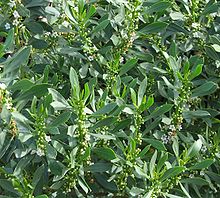- Myoporum insulare
-
Common Boobialla 
Myoporum insulare at Black Rock, Victoria Scientific classification Kingdom: Plantae (unranked): Angiosperms (unranked): Eudicots (unranked): Asterids Order: Lamiales Family: Scrophulariaceae Genus: Myoporum Species: M. insulare Binomial name Myoporum insulare
R.Br.[1]Synonyms - Bertolonia glandulosa Spin
- Myoporum adscendens R.Br.
- Myoporum glandulosum (Spin) Spin
- Myoporum mucronulatum A.DC.
- Myoporum serratum var. glandulosum (Spin) Benth.
- Myoporum serratum var. obovatum Benth.
- Myoporum tasmanicum A.DC.
- Myoporum tetrandrum var. adscendens (R.Br.)
- Myoporum tetrandrum var. glandulosum (Spin) Domin
Myoporum insulare is a shrub or small tree which occurs on dunes and coastal cliffs in Australia.[2] Common names include Common Boobialla, Boobialla, Native Juniper and, in Western Australia, Blueberry Tree.[1][3]
It has thick, smooth green leaves which are 3 to 9 cm long and 7 to 22 mm in width with edges that are either untoothed or toothed toward the apex. White flowers with purple spots appear in the leaf axils in clusters of 3 to 8 and are 6 to 8 mm in diameter.[4] Peak flowering times are July to February in Western Australia and October to December in south-eastern Australia.[2][3] The smooth, rounded fruits are purple to black and 4.5 to 9 mm in diameter.[4]
The species was first formally described by botanist Robert Brown in Prodromus Florae Novae Hollandiae in 1810.[1]
Distribution
Myoporum insulare occurs in New South Wales,[4] Victoria,[4] Tasmania,[4] South Australia[5] and Western Australia.[3] In New South Wales it occurs from Eden southwards, although an isolated occurrence was recorded much further north on Brush Island.[4]
Cultivation
Myoporum insulare may be used as a fast growing hedge or windbreak species, and withstands coastal winds and drought.[6]
References
- ^ a b c "Myoporum insulare". Australian Plant Name Index (APNI), IBIS database. Centre for Plant Biodiversity Research, Australian Government. http://www.anbg.gov.au/cgi-bin/apni?taxon_id=34640.
- ^ a b Costermans, L. (1981). Native Trees and Shrubs of South-eastern Australia. Australia: Rigby. ISBN 072701403x.
- ^ a b c "Myoporum insulare". FloraBase. Department of Environment and Conservation, Government of Western Australia. http://florabase.dec.wa.gov.au/browse/profile/7291..
- ^ a b c d e f New South Wales Flora Online: Myoporum insulare by R.J. Chinnock, Royal Botanic Gardens & Domain Trust, Sydney, Australia
- ^ "Myoporum insulare". Electronic Flora of South Australia Fact Sheet. State Herbarium of South Australia. http://www.flora.sa.gov.au/cgi-bin/texhtml.cgi?form=speciesfacts&family=Myoporaceae&genus=Myoporum&species=insulare. Retrieved 2008-05-29.
- ^ Cochrane, G.R., Fuhrer, B.A., Rotherdam, E.M., Simmons, J.& M. and Willis, J.H. (1980). Flowers and Plants of Victoria and Tasmania. A.H. & A.W. Reed. ISBN 0589502565.
Categories:- Myoporum
- Flora of New South Wales
- Flora of South Australia
- Flora of Tasmania
- Flora of Victoria (Australia)
- Eudicots of Western Australia
- Lamiales of Australia
- Garden plants
- Plants described in 1810
Wikimedia Foundation. 2010.
